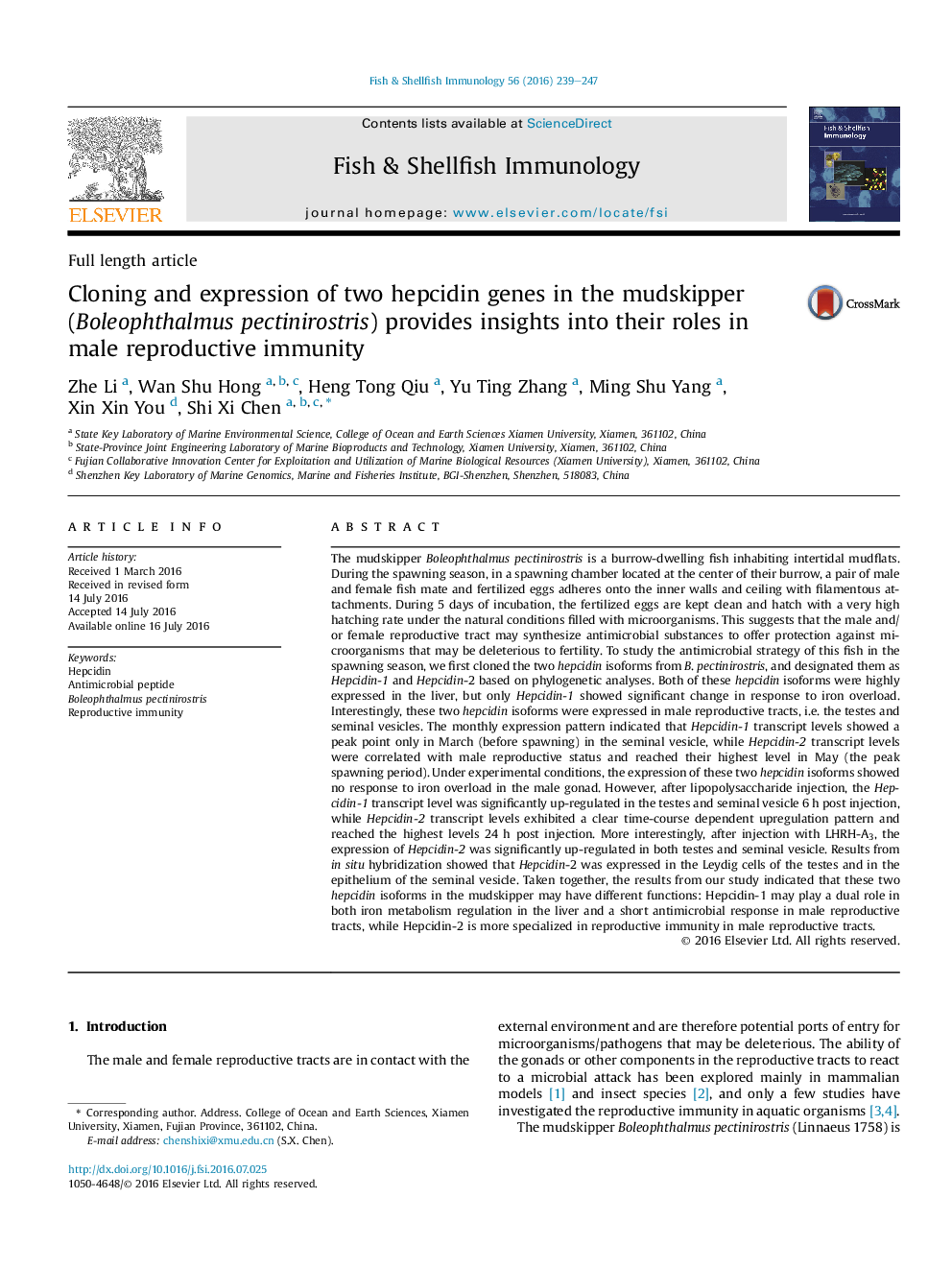| کد مقاله | کد نشریه | سال انتشار | مقاله انگلیسی | نسخه تمام متن |
|---|---|---|---|---|
| 8499034 | 1553618 | 2016 | 9 صفحه PDF | دانلود رایگان |
عنوان انگلیسی مقاله ISI
Cloning and expression of two hepcidin genes in the mudskipper (Boleophthalmus pectinirostris) provides insights into their roles in male reproductive immunity
دانلود مقاله + سفارش ترجمه
دانلود مقاله ISI انگلیسی
رایگان برای ایرانیان
کلمات کلیدی
موضوعات مرتبط
علوم زیستی و بیوفناوری
علوم کشاورزی و بیولوژیک
علوم آبزیان
پیش نمایش صفحه اول مقاله

چکیده انگلیسی
The mudskipper Boleophthalmus pectinirostris is a burrow-dwelling fish inhabiting intertidal mudflats. During the spawning season, in a spawning chamber located at the center of their burrow, a pair of male and female fish mate and fertilized eggs adheres onto the inner walls and ceiling with filamentous attachments. During 5 days of incubation, the fertilized eggs are kept clean and hatch with a very high hatching rate under the natural conditions filled with microorganisms. This suggests that the male and/or female reproductive tract may synthesize antimicrobial substances to offer protection against microorganisms that may be deleterious to fertility. To study the antimicrobial strategy of this fish in the spawning season, we first cloned the two hepcidin isoforms from B. pectinirostris, and designated them as Hepcidin-1 and Hepcidin-2 based on phylogenetic analyses. Both of these hepcidin isoforms were highly expressed in the liver, but only Hepcidin-1 showed significant change in response to iron overload. Interestingly, these two hepcidin isoforms were expressed in male reproductive tracts, i.e. the testes and seminal vesicles. The monthly expression pattern indicated that Hepcidin-1 transcript levels showed a peak point only in March (before spawning) in the seminal vesicle, while Hepcidin-2 transcript levels were correlated with male reproductive status and reached their highest level in May (the peak spawning period). Under experimental conditions, the expression of these two hepcidin isoforms showed no response to iron overload in the male gonad. However, after lipopolysaccharide injection, the Hepcidin-1 transcript level was significantly up-regulated in the testes and seminal vesicle 6Â h post injection, while Hepcidin-2 transcript levels exhibited a clear time-course dependent upregulation pattern and reached the highest levels 24Â h post injection. More interestingly, after injection with LHRH-A3, the expression of Hepcidin-2 was significantly up-regulated in both testes and seminal vesicle. Results from in situ hybridization showed that Hepcidin-2 was expressed in the Leydig cells of the testes and in the epithelium of the seminal vesicle. Taken together, the results from our study indicated that these two hepcidin isoforms in the mudskipper may have different functions: Hepcidin-1 may play a dual role in both iron metabolism regulation in the liver and a short antimicrobial response in male reproductive tracts, while Hepcidin-2 is more specialized in reproductive immunity in male reproductive tracts.
ناشر
Database: Elsevier - ScienceDirect (ساینس دایرکت)
Journal: Fish & Shellfish Immunology - Volume 56, September 2016, Pages 239-247
Journal: Fish & Shellfish Immunology - Volume 56, September 2016, Pages 239-247
نویسندگان
Zhe Li, Wan Shu Hong, Heng Tong Qiu, Yu Ting Zhang, Ming Shu Yang, Xin Xin You, Shi Xi Chen,